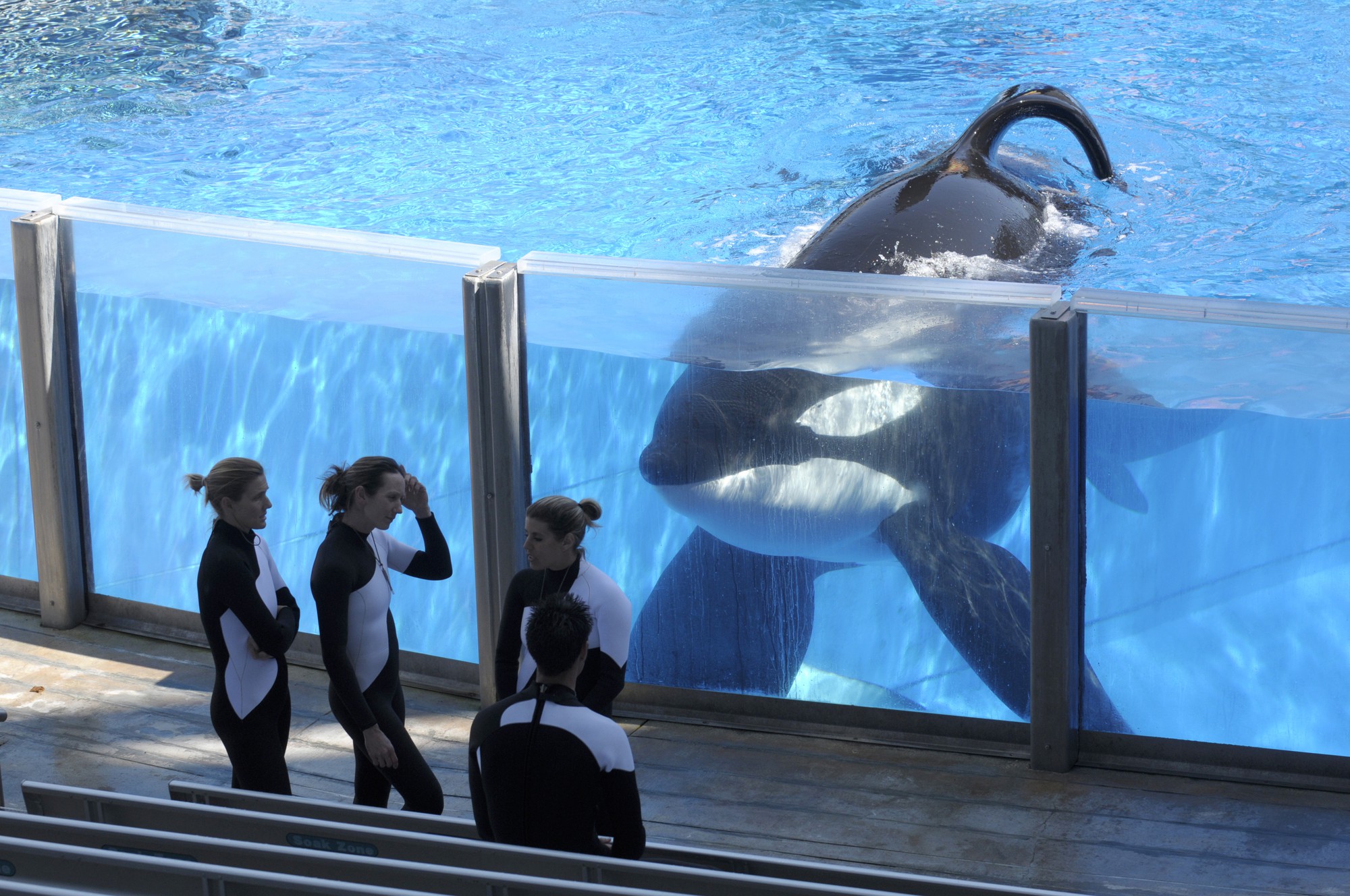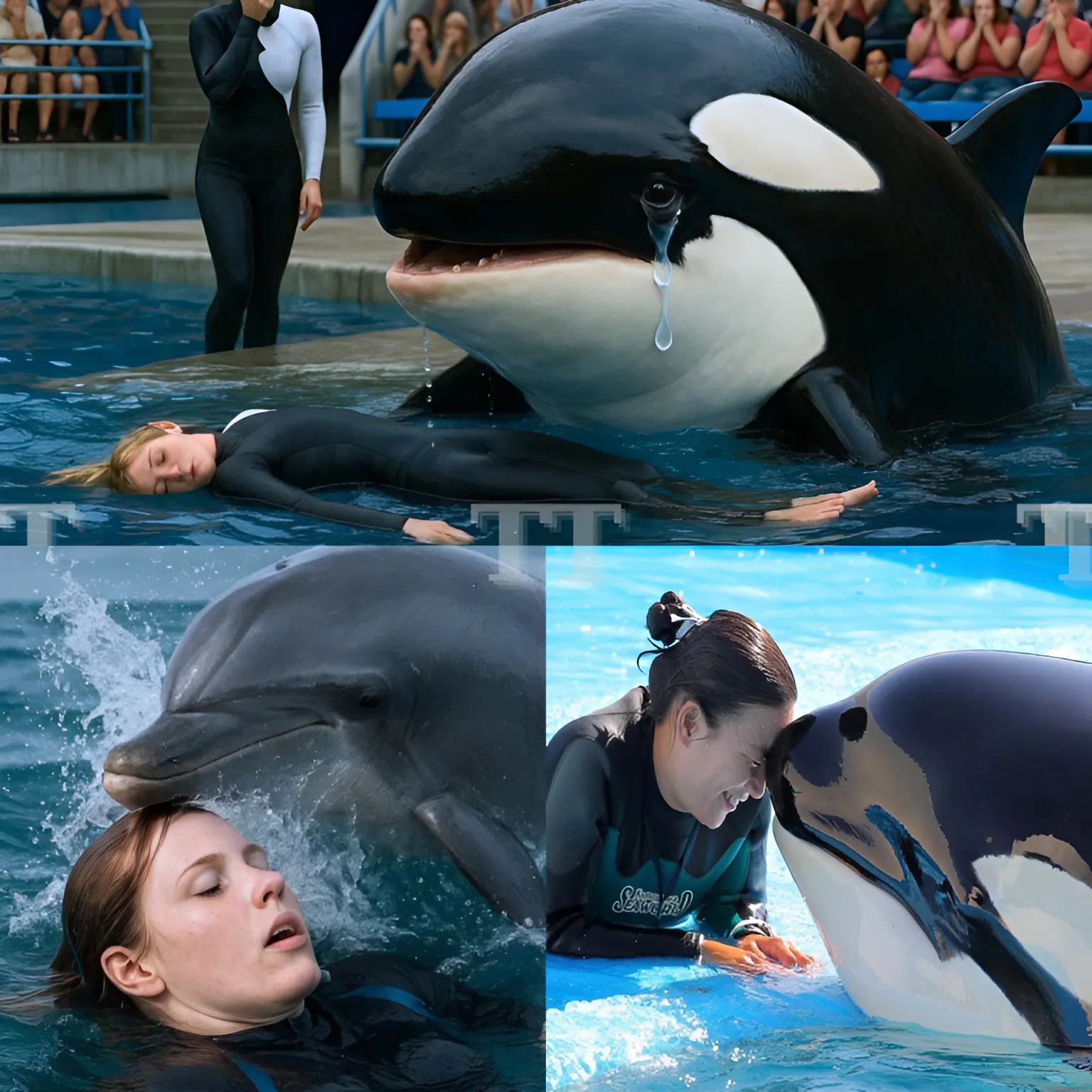Heart of the Sea: The World Holds Its Breath as a Trained Dolphin Resurfaces After a Sudden, Terrifying Accident
San Diego, CA — No one in the crowd that afternoon expected anything other than a lighthearted marine show, the kind families go to for laughter and splashing water. Children sat on the edge of their seats, parents held phones ready, and trainers backstage prepared for another smooth performance. But within minutes, what began as a routine display of athletic grace and human–animal partnership spiraled into a moment so shocking, so emotionally charged, that the entire audience found themselves holding their breath.
At the heart of it all was Nalu, a trained bottlenose dolphin known for her speed, precision, and uncanny intelligence. She had performed at the park for nearly nine years, beloved by both staff and audiences for her spirited leaps and playful demeanor. But on this day, she would become something far more than an entertainer. She would become a hero.
The Calm Before the Chaos

Like every show, the performance began with choreographed music and a dazzling display of synchronized motions between Nalu and her longtime trainer, Mira. Their connection was visible—Nalu circling Mira’s legs, Mira diving beside her, the two resurfacing in perfect harmony. For years, they had moved as if they shared the same instincts.
The sequence continued with acrobatic leaps, coordinated spins, and diving patterns rehearsed hundreds of times. But when the music shifted toward the final routine—a high-velocity platform dive—Mira made a sharp sprint across the narrow ledge to cue Nalu. The surface of the platform was still slick from the previous splash, something impossible to see from the stands.
Her foot slipped.
The fall looked almost harmless at first—a sudden drop, a splash, then silence. Some audience members laughed for a split second, thinking it was part of the choreography. But the seconds passed without Mira resurfacing. What replaced the laughter was stillness, confusion, growing dread.
Nalu dove immediately.
The Moment the World Froze
Witnesses later described the same surreal sensation: time slowing, the entire stadium going silent except for the lapping of water. Trainers on the sidelines sprinted, emergency whistles pierced the air, someone shouted for ropes and flotation devices.
But Nalu reached Mira first.
She plunged deeper than any human diver could react, disappearing into the blue shadows. Ten seconds passed. Fifteen. Twenty. Then suddenly, a ripple cut across the water and Nalu rose to the surface—not alone, but balancing Mira on her back, pushing her upward with steady force, keeping her head above water.
People stood. Some cried. Others gasped or covered their mouths.
“It didn’t look like instinct,” one mother said afterward. “It looked like intention. Like she knew Mira needed her.”
With a powerful stroke of her tail, Nalu guided Mira toward the edge of the pool until two trainers reached down to pull her out. Mira coughed up water, dazed but conscious. The relief that washed over the crowd felt like a physical wave—parents embracing their children, strangers hugging strangers, applause erupting long before Mira could even sit upright.
Nalu circled quietly, watching.
Understanding the Bond

Later that evening, marine biologists held a press conference to explain what had happened. Dolphins, they said, are among the rare species capable of genuine empathy-driven rescue behavior. In the wild, dolphins support injured pod members by pushing them to the surface to breathe. They’ve even been documented saving humans from drowning, shark attacks, and exhaustion.
But Nalu’s actions went beyond instinct.
For nine years, she and Mira trained together daily, often spending more time with each other than with anyone else. Mira taught Nalu complex signals. Nalu responded with her own whistles and attention cues. They communicated, trusted, and depended on each other.
“People underestimate how deep these bonds go,” said Dr. Leclerc, the park’s senior marine specialist. “Nalu didn’t just see a distressed human. She saw her human.”
According to the report, Nalu would have recognized that Mira’s body was limp, her movements nonexistent, her breath compromised. She reacted faster than any human could.
“I owe her my life,” Mira told reporters through a shaky smile. “I always knew she was special, but I never imagined this.”
What Happened Underwater?
Hours after the incident, marine behaviorists reviewed underwater camera footage. It showed Mira falling at an angle that stunned her on impact, sinking faster than expected. Nalu pivoted mid-swim, changed direction instantly, and accelerated toward Mira with a burst of speed few dolphins display outside emergency situations.
At approximately eight feet below the surface, Nalu reached Mira’s sinking form, nudged her gently until her body aligned horizontally, then lifted her with slow, controlled movements honed through years of buoyancy training.
Trainers believe that the combination of her natural instinct and her years of working with humans allowed her to assess the dire situation within milliseconds.
“That’s intelligence,” said Dr. Leclerc. “That’s emotion. That’s awareness.”
The Audience Reaction
For the audience, the event shifted something fundamental. A marine show is usually a spectacle—fun, exciting, choreographed entertainment. But that day, entertainment transformed into a life-or-death drama.
Parents who brought their children for lighthearted fun found themselves explaining the reality and complexity of animal intelligence. Teenagers recorded tearful TikToks about witnessing “the most incredible thing I’ve ever seen.” Elderly visitors, some of whom had seen countless shows over decades, said they would never forget this moment.
When Mira was carried away to the medical bay, she waved weakly to reassure the audience. The entire stadium roared.
Meanwhile, Nalu did something no one expected. Instead of disappearing underwater or retreating behind the scenes, she slowly circled the pool, surfacing again and again as if searching the stands—looking for confirmation, perhaps, that everything was all right.
People cheered her name until the entire arena vibrated.
A New Kind of Hero
In the days that followed, the story spread far beyond San Diego—picked up by national outlets, wildlife researchers, and social media, where “#NaluTheHero” trended worldwide.
Animal-rights advocates praised the testimony as evidence of dolphin sentience. Marine scientists advocated for deeper studies into dolphin emotional intelligence. Some critics reignited debates about marine parks and captivity, though even they acknowledged that Nalu’s act was extraordinary.
But the heart of the story was not political.
The heart was the bond between a human and an animal—a friendship formed through years of trust, training, shared routines, and silent communication.
Mira’s Recovery and Nalu’s Reward
Mira recovered quickly, suffering only bruises and a mild concussion. When she returned to see Nalu days later, staff members said the dolphin reacted with unmistakable excitement—rapid whistles, tail slaps, and a leap so high it startled everyone.
“She kept nudging me,” Mira said. “Almost like she was scolding me for scaring her.”
As for Nalu, she received fresh enrichment toys, extended rest time, and an outpouring of global affection. But perhaps the most meaningful reward came from Mira herself: a quiet moment at the pool’s edge, face to face, hands touching smooth skin.
“No training, no applause,” Mira said. “Just gratitude.”
A Story That Stays With Us
People attend marine shows expecting excitement. But what they witnessed that afternoon was something infinitely more powerful:
A demonstration of instinct sharpened by partnership.
A moment where an animal recognized human distress and responded not as a performer, but as a protector.
A reminder that intelligence and compassion are not limited to our species.
It is rare for a story to change the way people think about the world. But on that day, as hundreds stood in a stadium watching a dolphin save a life, something fundamental shifted.
It was not just a show anymore.
It was a reminder that beneath the surface of the water — and beneath the surface of our assumptions — there lies a depth we rarely acknowledge.
A depth of loyalty.
A depth of connection.
A depth of heart.
And sometimes, it rises to meet us.
